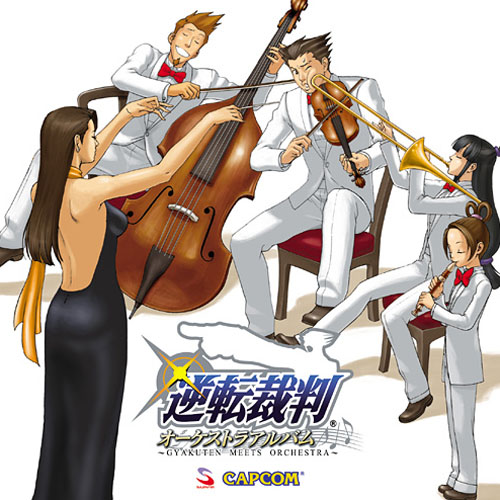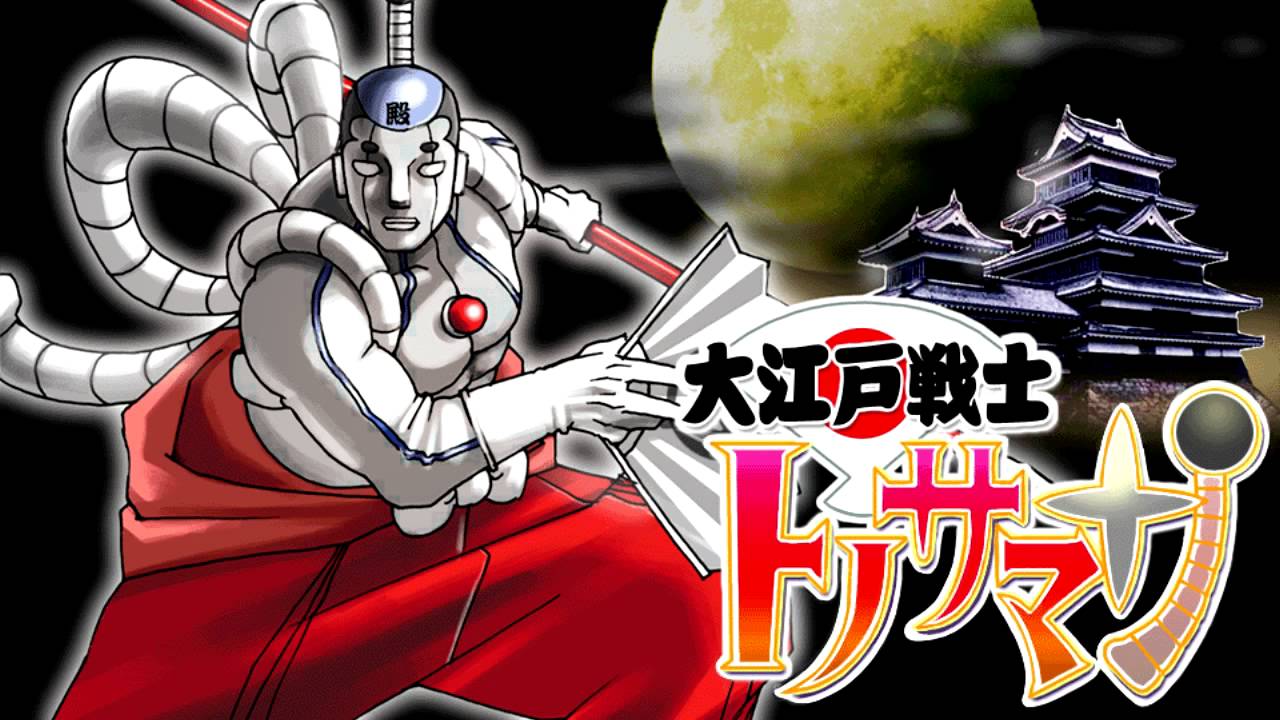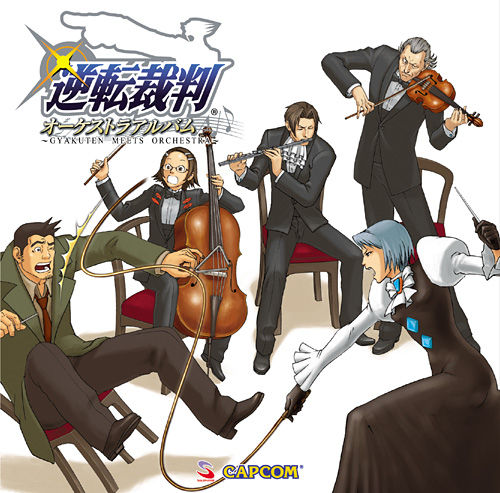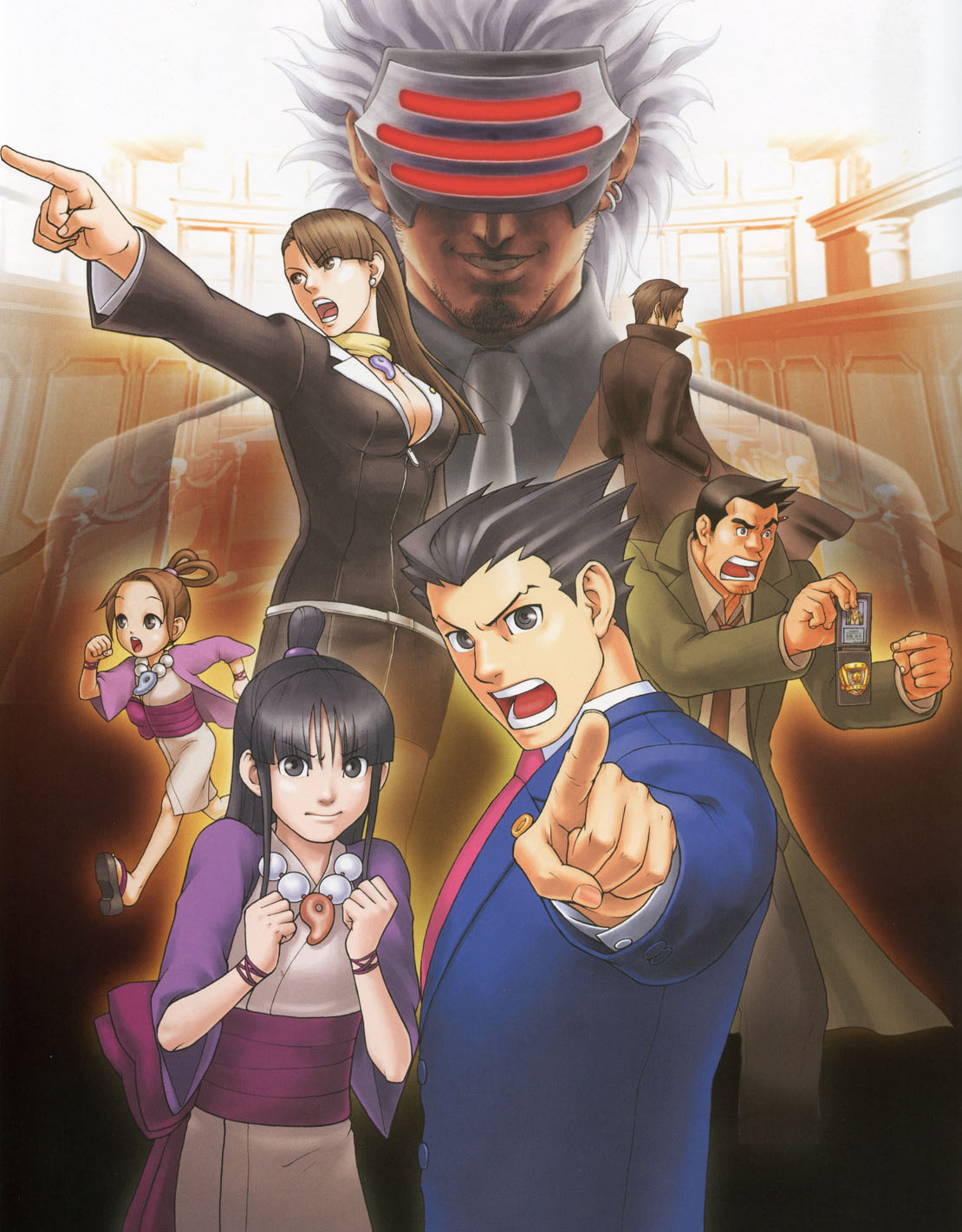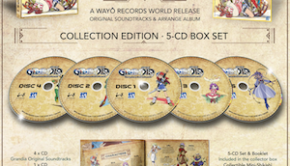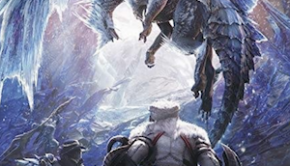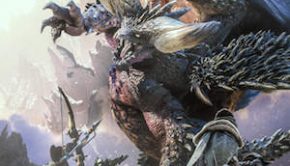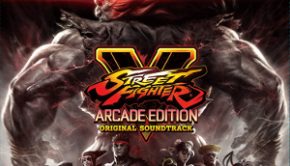Ace Attorney Meets Again -Orchestra & Jazz-
 |
Album Title: Ace Attorney Meets Again -Orchestra & Jazz- |
| Record Label: Suleputer |
|
| Catalog No.: CPCA-10380/1 |
|
| Release Date: March 8, 2015 |
|
| Purchase: Buy at CDJapan |
Overview
The Ace Attorney series has always remained one of my personal favorite game franchises of all time and in my view, represents some of the best narrative storytelling in the entire medium. There are many reasons as to why Phoenix Wright and the gang are so beloved worldwide by fans, even now after almost 15 years. Its quirky characters that the players learn to care for immensely, in-depth plots which maintain a clever mix of humor and drama, charming pixel art, and the unforgettable soundtracks have all made the franchise an everlasting property for Capcom. Usually having almost no voice acting, these scores in particular were essential in setting the right emotions for each scene.
Practically unheard of at the time for a handheld game soundtrack, Ace Attorney was given two live instrumental arrange albums in 2006 and 2007. The first was an orchestral one that combined real instruments with high quality synth, while the other one was a recording of a jazz ensemble doing improvised medley covers of the series’ various themes. These releases were some of my first true exposures to video game music, so they’ve always held a nostalgic place for me. Unfortunately, they went out of print long ago and typically fetched high prices on the secondary market. Luckily, Capcom issued a re-release of both discs in 2015 as one reasonably affordable set with the title Ace Attorney Meets Again ~Orchestra and Jazz~. After all these years and with a fresh release, do these performances and arrangements still hold up?
Body
Orchestra
I should note that there are actually two separate orchestral albums that exist for Ace Attorney. The first is what’s included here: the original 2006 Ace Attorney Meets Orchestra album, which technically was not a full symphonic recording. While it utilized quite a bit of live instrumentation, it additionally had some synthesized parts which made for a somewhat uneven listening experience. The other album, Ace Attorney Special Courtroom 2008 Orchestra Concert, actually was fully orchestral. This one featured new tracks, somewhat different arrangements, and was performed by the Tokyo Philharmonic Orchestra in conjunction with a DVD release of their live concert. Both albums were arranged by series composer and industry veteran Noriyuki Iwadare, but in my view it would have been more ideal for Capcom to include the 2008 recording over the 2006 version. Regardless, what we have still can be considered enjoyable, as the arrangements prove to be well done for the most part.
A medley for the three “Objection!” themes gets the album off to a rousing start. The strings play the famed loop from the first game, while the brass provide bombastic accompaniment. At roughly the one minute mark, the strings conclude the melody while the brass segues them into the second theme. Akin to another verse, this section contains rising notes from strings, with cadenza-like overtones provided by brass and marionettes. The woodwinds introduce the tertiary “Objection” melody, with the strings switching over to harmony. All sections combine together to conclude the track strongly. Overall, an excellent showcase for Iwadare’s exceptional arranging talents and a classy opener in all forms.
Phoenix Wright’s plucky and bubbly assistant Maya Fey earns herself an arrangement strongly reminiscent of a Baroque-era chamber piece, complete with a harpsicord. The polyphonic melody features no brass or woodwinds, but rather is exclusively performed on strings. Iwadare’s imitation is tastefully done, this being a spot-on emulation of what one would here from Bach or Handel. A highlight is the mid-point, where the harpsicord takes over the melody and the strings provide pizzicato harmony. The higher and lower strings move back and forth with each other soon afterwards, creating an excellent dynamic. In all honestly, I actually find this version to be far more interesting than the 2008 concert recording.
Speaking of which, another arrangement I feel more partial too is Kaori Komuro’s interpretation of the fan favorite Steel Samurai theme. While the 2008 version was admirably done, it lacked a key component which makes this version better: traditional Japanese instruments. Opening proudly with brass, taiko percussion, and koto strings, the heroic theme of the warrior from Neo Olde Tokyo rings through. Halfway through, the tone suddenly changes from heroic to melancholic, provided by a romantic violin solo of the theme. While certain elements are obviously synthesized, it remains a must-listen.
Rival prosecutor Miles Edgeworth is given a regal-sounding brassy motif with “Great Revival.” While the emotions are there, the overall instrumentation unfortunately feels artificial and unconvincing. It’s not a bad track per se, but when there’s a better version out there with the concert album, it’s more difficult for me to get into. For the arrangement of Godot’s theme, on the other hand, this is less of a problem. A coffee-addicted prosecutor with a troubled past, Godot is another character who remains extremely popular with fans and is noted for his jazzy character piece. The arrangement included here gives full focus to the gorgeous saxophone melody, while romantic strings provide excellent backing, moving together in beautiful harmony. I personally prefer the performance with the Tokyo Philharmonic, but this arrangement adds in some interesting choices such as handing the melody to violin, cello, and eventually piano. Either way, the listener is treated to an excellent rendition of one of the best pieces of video game music out there. Essential, regardless of the version.
On the other side of things, we have three “Court Suites” dedicated to each game in the trilogy. The first game’s music, composed by the ever great Masakazu Sugimori, is the best of the bunch. It begins with a rising string section and booming brass, while a solo violin provides background trills. The scope feels huge, and the atmosphere feels even tenser than in-game. Everything soon quiets down, and at 1:40 the cross-examination theme comes in on pizzicato. The tension slowly returns, and the orchestra bursts into the allegro variation of the theme. Everything explodes into the intense cornered theme at 3:40, the frenetic but collected strings representing Phoenix Wright putting pressure on the true suspect. The trial grinds into a seeming halt, but the tempo quickly picks up into a satisfying conclusion. While not every single aspect is perfect, such as the synth once again being too obvious, it’s a fantastic and emotion-wrought rendition of some of the series’ best themes.
I was never too much of a fan of Akemi Kimura’s themes for the second game, Justice for All, and the arrangement doesn’t do much to change my mind. Naoto Tanaka’s arranged suite opens with another bombastic courtroom theme, but it doesn’t hold a candle to Sugimori’s, and the artificial elements are embarrassingly apparent. By the time the medley shifts into the cross-examination theme, the fact that we’re listening to about 70% synth really hampers my enjoyment for it. Things fare somewhat better with the cornered theme, the violin solo being notable, but again the electronic elements still prove to be distracting. Similar problems face the court suite for Trials and Tribulations, but the melodies by Noriyuki Iwadare are stronger than Kimura’s. Again though, the problem lies with the fact that the synth portions overwhelm the live instruments. Both are overall disappointing arrangements, and the medley collecting the entire trilogy on the 2008 album is a far better choice.
Moving on to the extraneous tracks, we have “Investigation ~ Mystery Suite” which begins quite strongly with a passionate rendition of detective Dick Gumshoe’s theme. It carries substantial weight, and generally good performances from each section. The more ambient middle section is interestingly done, but the latter portion of the medley questionably choices to use synthesized strings when live ones would have easily sufficed. “Kurain Genealogy” includes various themes related to the mystical Fey family such as “Psyche Lock” and “Hazakura Temple.” Once again, synth is used more than actual instruments. While it adds somewhat to the mysterious nature of these tracks, it feels out of place on what’s supposed to be an orchestral album.
Closing the disc is the emotional ending theme from the third game. The performance here does a pretty good job of capturing the pathos established with the tear-jerking climax without being melodramatic or schmaltzy. The violin solo is appropriately done, while the response from the other sections is done with general excellence. I know that I’m repeating myself here once again, but I still have to mention it. The 2008 version is still far better. With a piece of this caliber, synth instrumentation just doesn’t cut it. A similar fate befalls the objection theme for Apollo Justice, included here as a bonus track. As expected the orchestral performance is as good as it can be, but the rest is unfortunately fake-sounding.
Don’t get me wrong, there are quite a few arrangements on this disc that I liked. The themes for Maya Fey and the Steel Samurai are great, the first court suite is exceptional, and the jazz/orchestra combo for Godot is gorgeous. That being said, I couldn’t help but wish I was listening to the 2008 album most of the time. It is simply stronger in nearly every way, regardless of some of the more interesting arrangements here. While not a terrible album by any stretch of the imagination, it clearly shows its age.
Jazz
The jazz portion of this release is where everything really shines. I’ve had the original release constantly looped in my music library for years, and even now it remains an old favorite of mine. Performed by the Metamorphosis Jazz Band, this is as close to perfection as it gets when it comes to the best album in the series and nearly every aspect of it is masterful.
Right off the bat, we’re in for a treat the moment those first brass notes, bass riffs, and percussion beats introduce the very first track. Titled “Court Begins in Blue Note Scale,” this piece is medley of various courtroom themes from the first game. This is far from a straight playthough of the melodies though. It wouldn’t be jazz without improvisation, and it’s brimming with it here. The saxophone begins with a brief performance of the courtroom lobby theme, but adds a ton of variation that I didn’t even think was possible. It’s joined by other brass instruments, which all contribute something unique. The pace changes somewhat at the two minute mark when the cross examination theme is introduced. While the saxes provide the melody, the piano plays some improvised keys while the rest of the brass slowly rise up into a laid-back performance of the cornered theme. The medley returns to its simple beginnings with the lobby theme before closing off casually. From start to finish, it’s an utterly fantastic interpretation of what are initially only simple melodies turned into multi-layered complex jazz pieces.
Iwadare additionally dedicates “Blue Note Scale” medleys to the other two games from the series, both being just as strong. I even enjoyed Akemi Kimura’s themes, which I didn’t care much for in-game. Opening with a bass solo later joined with a brassy riff, the suite for Justice for All starts off with a classy take on its lobby theme. The sax soon follows with its own respective solo. After that takes a backseat, focus is taken to the piano with bass accompaniment. The spotlight is then given to the trumpets as they boldly play the cross-examination theme, while the piano sustains its improvisation. Once bland melodies, I found them to be far more interesting due to Iwadare’s expert arrangement and varied performance from the ensemble. Consider me impressed.
Even better is his track for Trials and Tribulations. Bouncy and upbeat, the courtroom lobby theme is groovily played by the group in a brassy opening performance. The trumpet takes a resolute cadenza solo for quite some time before the brass return in ensemble. Moving on to cross examination, the saxes take over as the piano continues its background scales. Even more impressive is the drum solo which takes center stage in a dazzling display. Out of all the tracks, this is the one I find myself re-visiting the most due to its various levels of instrumentation and complexity. The medley for the three “Objection!” themes continues this format. First performed on sax, the first melody is backed by bass and followed by a trumpet solo. The sax continues hints of the theme, followed by some more flavorings from the other sections, and then continues with the second and third melodies. As some of the most popular pieces from the game, listeners will not walk away disappointed.
Equally impressive is Iwadare’s transformation of simplistic character themes into full-fledged melodies. “Miles Edgeworth ~ Great Revival,” for example, originally had a short melody with very little development. Not so here. While the theme is apparent throughout the piece, Iwadare focuses much attention on each individual instrument with solos that work in conjunction with it. Funky keyboard synths, brassy harmonies, and a memorable saxophone line; it turned out better than I could have possibly imagined. “Furio Tigre ~ Swingin’ Tiger,” on the other hand, was already a jazz-inspired theme to begin with. Opening with a dance-like sax motif and bass line, the Latin-tinged piece keeps a consistent pace, shifting to and fro. The bass has some excellent backing, with the solos from the synths and trumpet being the highlights. All around, very strong character pieces with great color and innovation.
Changing the album’s tone of generally upbeat pieces, Iwadare additionally adds some melancholy with his slower-paced, blues-inspired arrangements. While some purists may be turned off by it, “The Steel Samurai” is transformed from a heroic theme to a downtrodden ballad. To be fair though, this is an arrangement from the version heard in Justice for All, so it’s not like it comes out of left field. Emphasis is given to the saxophone with its wistful melody, as it carries the bulk of the piece with the theme. The piano and bass give it a lounge-tinged flair, making the soundscape akin to something one would here at a coffee house or late-night radio broadcast.
More notably and probably the best track on the album by far, is Iwadare’s arrangement of Godot’s theme, a fan favorite that was heavily jazzy during its in-game appearance. This time around though, Iwadare’s true musical intentions with the character can fully show, not hampered by the limited GBA soundchip. And what an achievement it is. Elegant piano bars lead way for the saxophone to shine through with its gorgeous performance of the mysterious coffee-drinking prosecutor’s theme. The piano returns with a soothing answer to the sax’s ambiguous call, and the two work off each other in a sonorous duet. After the melody runs its course, both instruments pull a few more tricks in delivering improv consistent with Iwadare’s musical intentions. Then comes in the bass, starting off subtly confined to the background, but slowly developing to the front in taking over the established first theme. The sax returns to where the piece started, reintroducing the melody and taking the piece off to a fading conclusion. Simply beautiful in all aspects, it’s Godot’s theme as it’s meant to be heard.
Concluding the album with immensely satisfying closure is the ending theme to “Rise from the Ashes,” an exclusive scenario packaged with later releases of the first game. While the original theme conveyed the right emotions of Phoenix Wright winning a long trial, Iwadare’s jazz arrangement pulls no stops in delivering something all the more complete. The addictive bass line which runs through the entire track leads the saxophone into its victorious cry as Phoenix and his friends walk out of the courtroom. Soon joined by the other brass instruments, the melody progresses into its peak. All elements, save for the bass, pull back at the 2:20 mark. The saxophone re-enters as it plays around the bass’ line and airy piano keys. Moving back and forth between every instrumental combination one can imagine, the piece rouses off to a gratifying end. The only thing left is a bonus track dedicated to the character of Trucy Wright from Apollo Justice, which almost acts as a thematic epilogue to everything heard on this album. Unlike the rest of the tracks, the tone is more retro-inspired. The saxophone’s bouncy melody, the brass section’s rising harmonic assistance, and the synth’s groovy tones work together in excellent unison. Iwadare could have ended everything with the ending from Rise from the Ashes and it would have already been perfect, but this extra piece makes the overall experience all the more sweeter.
Ace Attorney Meets Jazz Soul ranks among my top video game albums and I find myself revisiting it regularly. This is the kind of disc one sits down and listens to with only once simply not being enough. Its rich musical layers, expert performances, classy solos, and superb arrangements make the experience fresh time and time again. Whether one is a die-hard Ace Attorney fan or simply a casual video game music listener, this is something that should be in everyone’s collection.
Summary
If I were to score things individually with this release, the orchestra disc would earn a 3.5 out of 5, and the jazz disc a perfect score. Rounding that off together, it gets what you see here. For the jazz arrangements alone, Ace Attorney Meets Again is entirely worth its asking price. The orchestra portion, while good on its own, is unfortunately inferior in most ways to the 2008 concert album. It really makes me wonder exactly why Capcom didn’t bother including it instead. In my opinion, they could have even made this a three-disc set containing everything. The price would have definitely been worth it. With what’s given though, listeners are still treated to an excellent release, the highlight being one of the best video game arranged albums of all time. For fans of the series, this is a must-own, and for non-fans it still garners a look. Seek it out immediately.
Do you agree with the review and score? Let us know in the comments below!
4.5
Posted on April 8, 2015 by Oliver Jia. Last modified on August 26, 2016.

